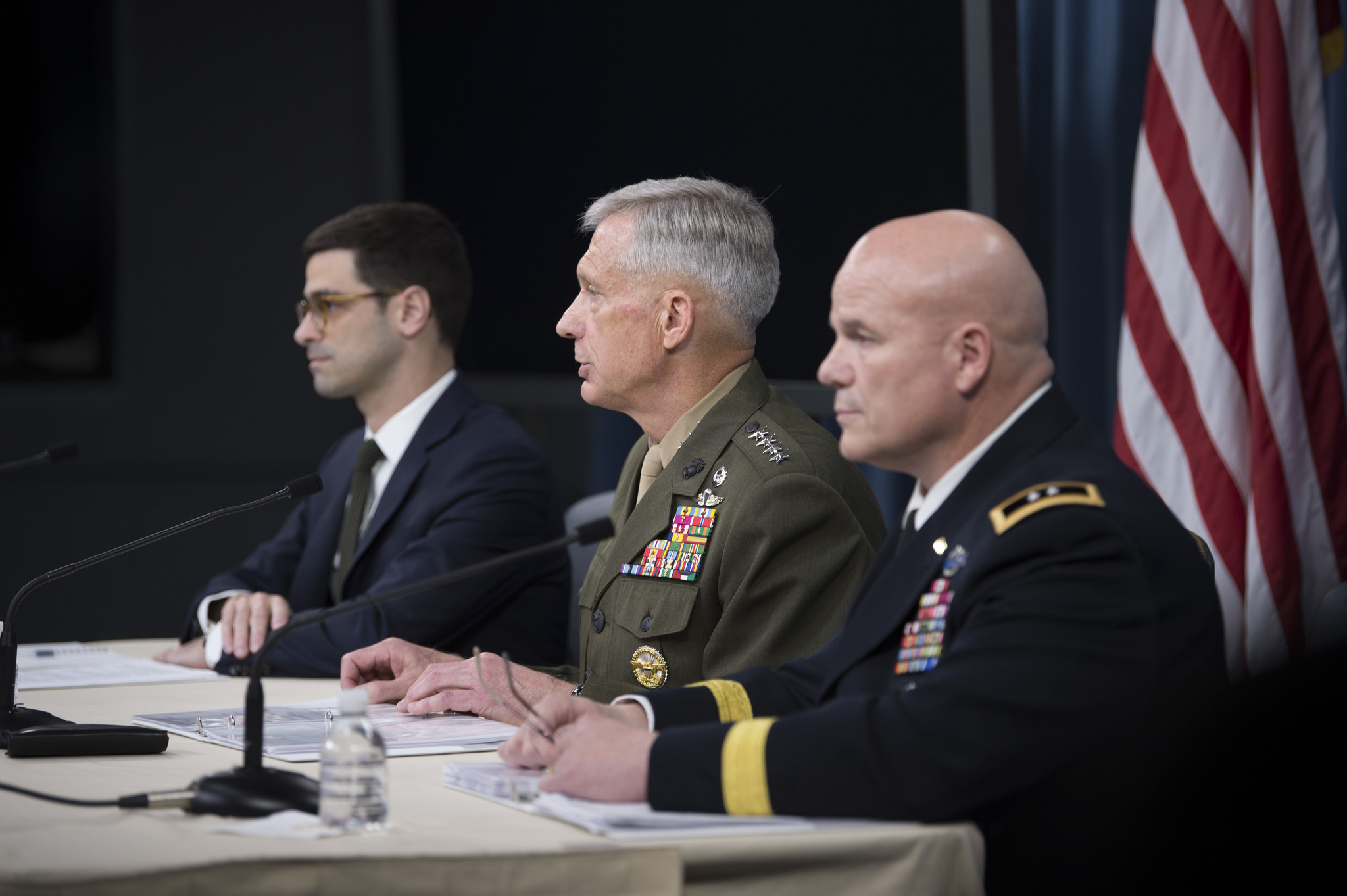
(left to right) Assistant Secretary of Defense for International Security Affairs Robert S. Karem, Marine Gen. Thomas D. Waldhauser, US Africa Command boss, and Army Maj. Gen. Roger L. Cloutier Jr., chief of staff for US Africa Command and lead investigating officer, brief the media on the results of the investigation of the Oct. 4, 2017 ambush in Niger at Pentagon in Washington, D.C., May 10, 2018. DOD photo by Navy Specialist 1st Class Kathryn E. Holm.
US special operations forces in Africa are paring down their operations, and will be supported by an increase in Air Force-provided surveillance from a large USAF operating location in Niger, following the Oct. 4, 2017, ambush in that country that killed four Green Berets.
The Pentagon on Thursday unveiled its long-anticipated investigation into the ambush, in which an under protected group of soldiers were surrounded and outgunned by more than 100 fighters in a mission that was not accurately portrayed by lower-level commanders to higher US Africa Command officials.
The ambush killed SSgt. Bryan Black, SSgt. Jeremiah ohnson, SSgt. Dustin Wright, and Sgt. La David Johnson.
The US Africa Command-investigation into the incident found that several failures in training, command oversight, and a lack of understanding of the special operations mission in the region led to the fatal attack. The investigation focused on interviews with more than 140 personnel, visits to the location of the incident, and review of video provided by ISR and French attack jets.
“With the conclusion of the investigation, it is my duty and obligation to make required changes and adjustments to how US military forces conduct daily operations on the African continent,” AFRICOM Commander USMC Gen. Thomas Waldhauser said during a Thursday Pentagon briefing. “Consequently, I will ensure the lessons learned are communicated to all levels within AFRICOM, as well as within the component commands and integrate these changes into our daily operational activities.”
The investigation did not highlight a single major point of failure, and did not specifically recommend any punishment for personnel involved. There will eventually be valor awards for the four fallen soldiers who continued to fight in their final minutes, Waldhauser said.
The team of Green Berets were accompanying Nigerien forces on what was originally portrayed in a concept of operations to be a routine counter terrorism reconnaissance mission to a village near Niamey, but instead was a kill or capture mission focused on a local ISIS leader. The investigation states that two Army captains did not accurately portray the mission and AFRICOM officials were unaware of the focus. Had they been, the mission would have required higher approval and likely more support, including air support and armored vehicles.
The patrol began Oct. 3, with a US remotely piloted aircraft accompanying the team from Niamey. The drone watched the nearby village for several hours, but the soldiers determined it was “cold” and ordered the RPA to fly further north to watch border crossing locations.
The ambush began at about 11:40 a.m. the next day, after the teams stopped in the village of Tongo Tongo for water. At first the group believed the enemy force was small and could be handled, so they did not initially call for support. More ISIS fighters emerged on vehicles and began to surround the forces. They were ordered to withdraw, though a truck containing three of the US soldiers, one US soldier on foot, and two Nigerien vehicles did not withdraw from the ambush site and were separated.
Waldhauser said that up until this point, US troops had “never seen anything in this magnitude” from ISIS in Africa, noting the ISIS fighters had tactical surprise.
The rest of the US and Nigerien forces had fled about 700 meters away. Their commander had ordered them to flee not knowing what happened to the four remaining soldiers.
It took an hour and 45 minutes for the first ISR aircraft to arrive on scene, said Army Maj. Gen. Roger Cloutier Jr., AFRICOM’s chief of staff who oversaw the investigation. Two French Mirage fighters arrived shortly after they were notified, and flew four show-of-force low passes at about treetop level to disperse the fighters. However, they were unable to identify targets as friend or foe without direct radio contact and did not engage. The Nigerien quick reaction force arrived four hours and 25 minutes after initial contact, and the medevac withdrew the fallen about five hours and 43 minutes after initial contact. ISIS fighters had removed all useable equipment from the US and Nigerien forces, and three bodies of US soldiers were found in ISIS trucks indicating they had tried to take them from the scene, Cloutier said.
Since the incident, the Pentagon and AFRICOM leadership have ordered US special operations forces to find ways to further mitigate risk, including limiting the missions that could include contact with enemy fighters. Those missions need a “strategic value” and must include target groups that pose a “strategic threat” to the US. There is a renewed emphasis on the “by, with, and through” focus of special operations, meaning that local forces need to be in the front and deal with potential fighting, Waldhauser said.
There will be a larger focus by AFRICOM, US Special Operations Command, and the US Army on pre-deployment and in-theater training, as well as the rehearsal of missions, to try to mitigate risk.
AFRICOM has provided access to more armored vehicles, “increased firepower,” and more capacity to limit response times. A major focus is on intelligence, surveillance, and reconnaissance capacity. USAF has an MQ-9 Reaper presence deployed to Nigerien Air Base 201 near Agadez with the 323rd Expeditionary Reconnaissance Squadron. USAF forces are building up this base in what has been called the largest US troop labor construction project in US history.
“We have beefed up a lot of things posture-wise with regards to these forces,” Waldhauser said.